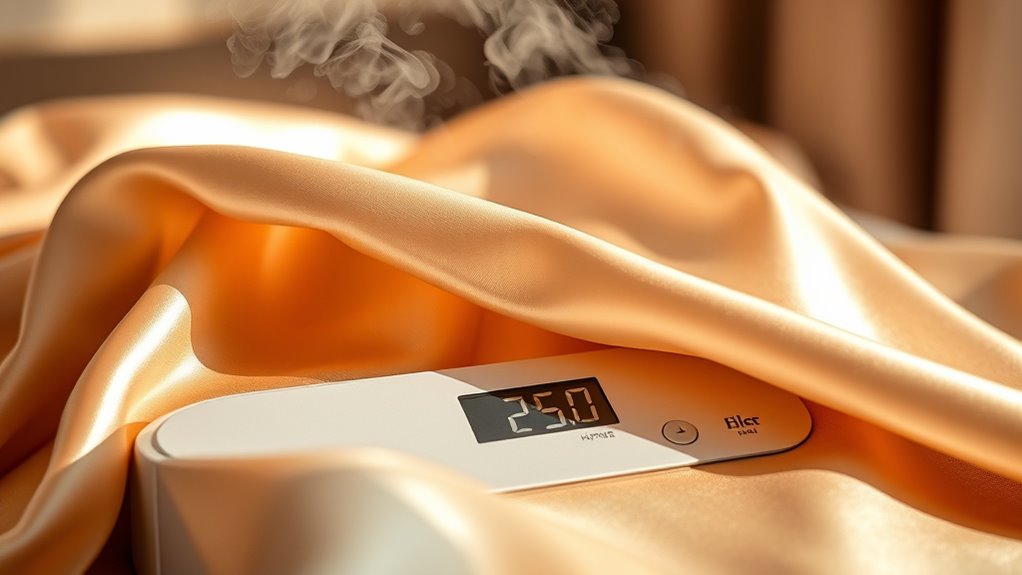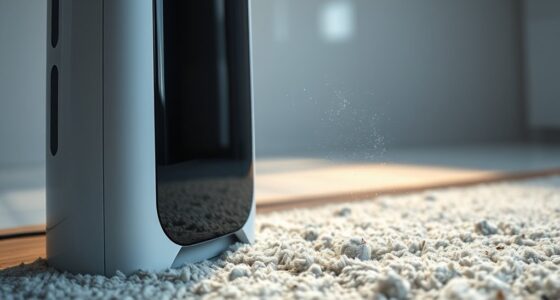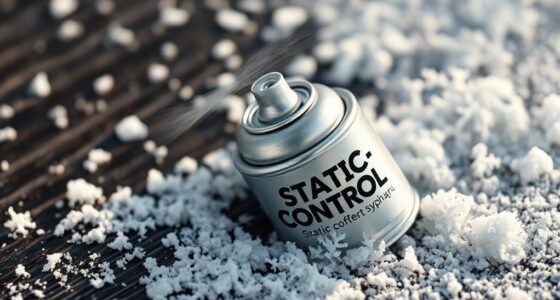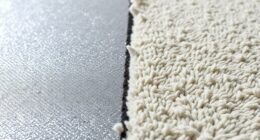To protect silk in dry climates, use a humidifier to maintain humidity levels around 50-55%, preventing the fibers from becoming brittle or cracking. Pair it with a reliable hygrometer to monitor moisture accurately, ensuring your environment stays consistent. Regularly calibrate your devices and avoid over-humidifying, which can lead to mold. Proper setup and maintenance will safeguard your silk, and exploring further can help you optimize your preservation efforts effectively.
Key Takeaways
- Maintain indoor humidity levels between 50-55% using reliable humidifiers to prevent silk from becoming brittle or moldy.
- Use calibrated hygrometers to accurately monitor humidity and adjust humidifier settings accordingly.
- Place humidifiers away from direct sunlight and vents to ensure even moisture distribution and avoid damage.
- Regularly clean and maintain humidifiers and hygrometers to prevent mold buildup and ensure consistent performance.
- Avoid over-humidification; balanced moisture levels preserve silk’s elasticity, color vibrancy, and structural integrity in dry climates.
Understanding the Importance of Humidity for Silk Preservation
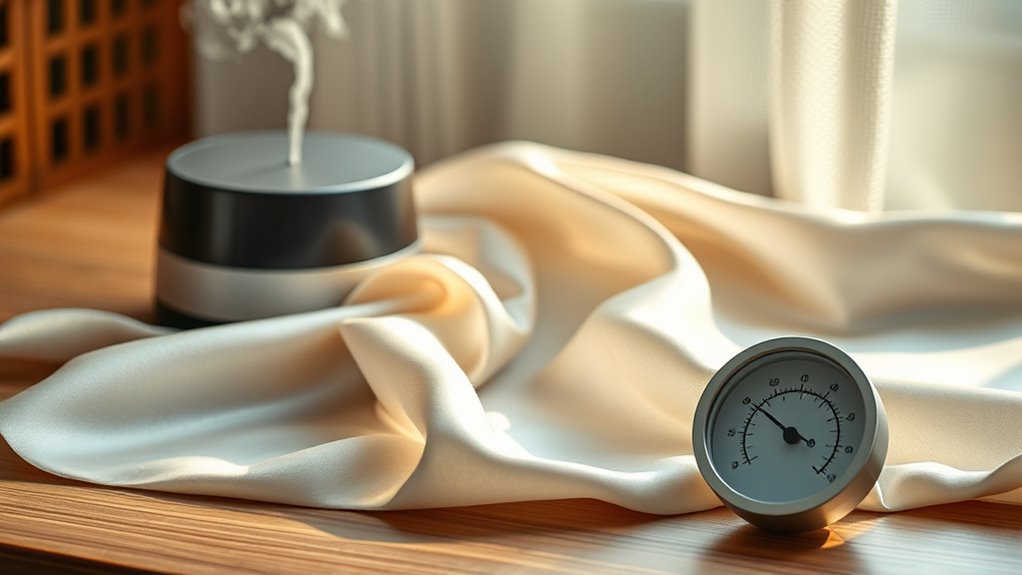
Since silk is highly sensitive to environmental conditions, maintaining proper humidity levels is vital for its preservation. When humidity is too low, silk can become brittle, reducing its fiber elasticity and increasing the risk of tears. Additionally, low moisture levels can compromise silk dye stability, causing colors to fade or shift over time. On the other hand, excessive humidity can promote mold growth and weaken the fibers. By controlling humidity, you help preserve silk’s natural flexibility and vibrant appearance. Maintaining the right moisture balance ensures that silk retains its structural integrity and color vibrancy for years. Proper humidity management is essential for safeguarding your delicate silk pieces from environmental damage, keeping them beautiful and intact. Implementing environmental control strategies ensures optimal conditions for long-term silk preservation.
How Humidifiers Help Maintain Optimal Moisture Levels
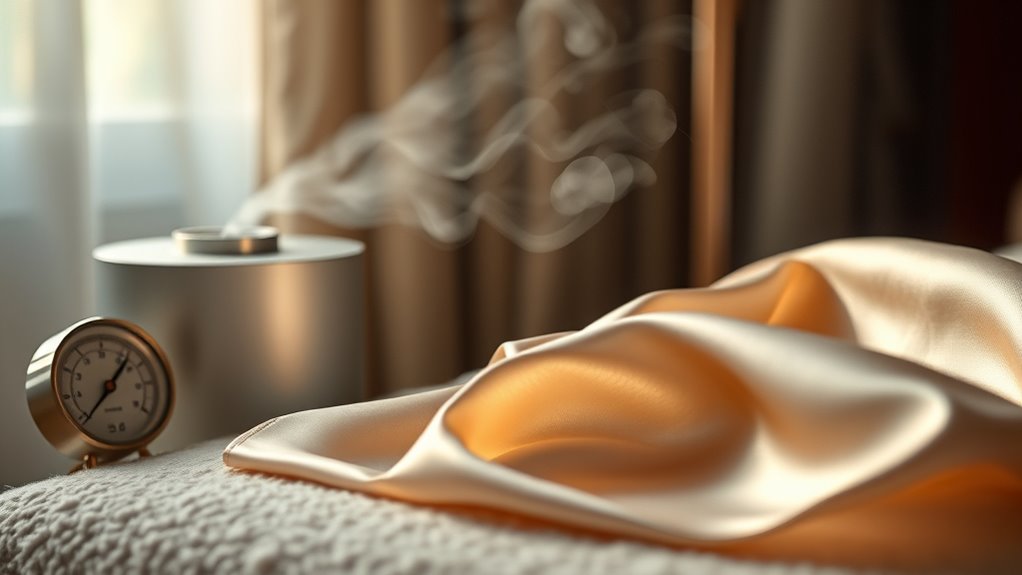
Humidifiers help you keep indoor humidity at ideal levels, preventing the air from becoming too dry or too damp. This balance not only protects delicate items like silk but also improves overall air quality. By maintaining best moisture, you create a healthier, more comfortable environment. Additionally, understanding the importance of balanced humidity can guide you in making informed choices for your home climate.
Balances Indoor Humidity
Maintaining proper indoor humidity levels is essential for comfort and health, and humidifiers play a key role in achieving this balance. When humidity stays within the ideal range, silk items like garments and art maintain their dye stability and fiber elasticity. Too dry air can cause silk to become brittle, while excess moisture may encourage mold. Using a humidifier ensures consistent moisture levels, protecting delicate fabrics and preserving their beauty. Consider this helpful guide:
| Humidity Level | Effect on Silk | Recommended Usage |
|---|---|---|
| Too Low | Silk dries out, dye fades | Use humidifier to add moisture |
| Ideal Range | Silk retains elasticity | Maintain with regular humidification |
| Too High | Silk absorbs excess moisture | Adjust humidifier settings |
Balancing indoor humidity keeps your silk safe and vibrant. Additionally, maintaining proper humidity levels can also help prevent mold growth on silk and other sensitive materials.
Prevents Silk Damage
Properly functioning humidifiers prevent silk damage by maintaining the ideal moisture level in your indoor environment. When humidity is too low, silk becomes brittle, risking cracks and tears, which can ruin delicate pieces. Maintaining proper humidity supports silk dyeing processes, ensuring colors stay vibrant and even. This is especially important for historical silk preservation, where dryness accelerates deterioration. By stabilizing moisture levels, humidifiers help preserve silk’s natural elasticity, preventing it from becoming fragile over time. Consistent humidity reduces the risk of damage during handling or display, protecting both new and antique silk textiles. Additionally, understanding the role of climate control is crucial in maintaining the longevity of silk artifacts. So, using a humidifier guarantees your silk remains supple, vibrant, and intact, whether for display, storage, or conservation efforts.
Enhances Air Quality
When your indoor air becomes too dry, it can lead to irritations, respiratory issues, and increased static electricity. Humidifiers help maintain ideal moisture levels, improving air quality. This benefits activities like silk dyeing and silk embroidery by preventing fibers from becoming brittle or overly fragile. Proper humidity supports vibrant silk colors and smooth embroidery stitches. To illustrate, humidifiers:
- Reduce airborne dust and allergens, creating a cleaner environment.
- Maintain consistent moisture, ensuring silk fibers stay resilient.
- Minimize static electricity that can damage delicate silk threads.
Types of Humidifiers Suitable for Silk Protection
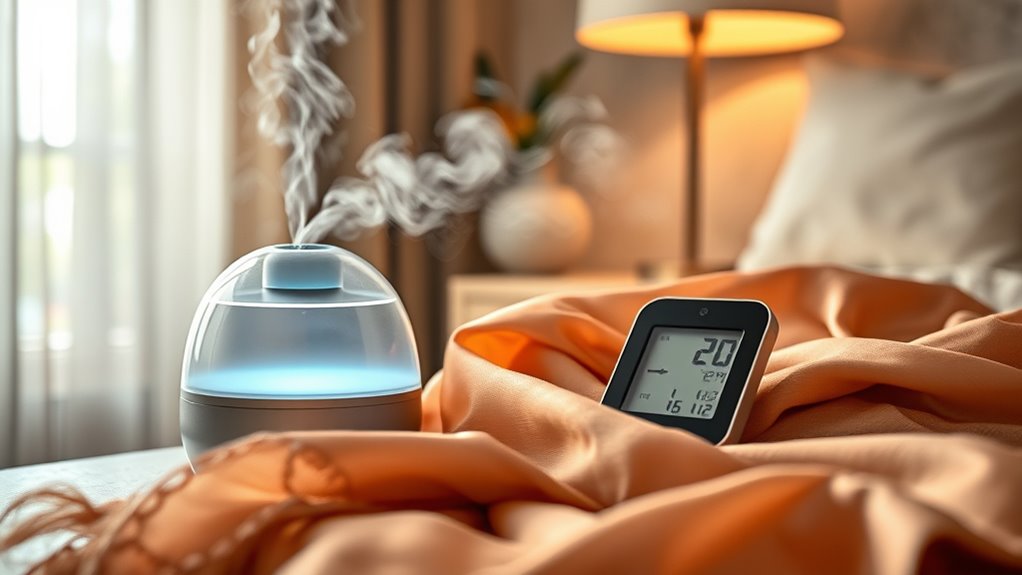
If you want to protect silk from damage caused by dry air, choosing the right humidifier is essential. Silk’s fiber structure is sensitive to low humidity, which can cause fibers to become brittle and fragile. Ultrasonic humidifiers are ideal because they add moisture quietly and maintain consistent humidity levels without disrupting the silk’s delicate fibers. Evaporative humidifiers work well too, as they naturally regulate humidity and prevent over-humidification, which can harm silk. Avoid steam vaporizers, as they produce high heat that might damage silk’s fibers and alter its appearance. The goal is to maintain a stable humidity level that minimizes the humidity impact on silk, preserving its strength, sheen, and longevity. Selecting the right type ensures your silk remains protected and beautiful. Additionally, understanding how contrast ratio affects visual clarity can help you better appreciate the quality of your display environment for silk viewing.
Choosing the Right Hygrometer for Accurate Humidity Monitoring

Choosing the right hygrometer is vital for accurately monitoring humidity levels and protecting your silk collection. To guarantee precision, consider these key features:
Selecting the right hygrometer ensures accurate humidity monitoring and silk preservation.
- Digital sensors for quick, accurate readings, especially in fluctuating environments.
- Analog gauges, offering a visual, easy-to-read display that’s reliable over time.
- Calibration options to maintain accuracy and prevent drift.
- Glycolic acid benefits include controlling moisture levels, which can be beneficial in maintaining proper humidity for silk preservation.
Digital sensors often provide real-time updates and are ideal for precise control, while analog gauges give a straightforward visual cue. Whichever you choose, make sure it’s easy to use and fits your setup. Accurate humidity readings are essential for silk preservation, especially in dry climates. By selecting the right hygrometer, you’ll keep your silk safe and maintain ideal conditions effortlessly.
Best Practices for Using Humidifiers and Hygrometers Together
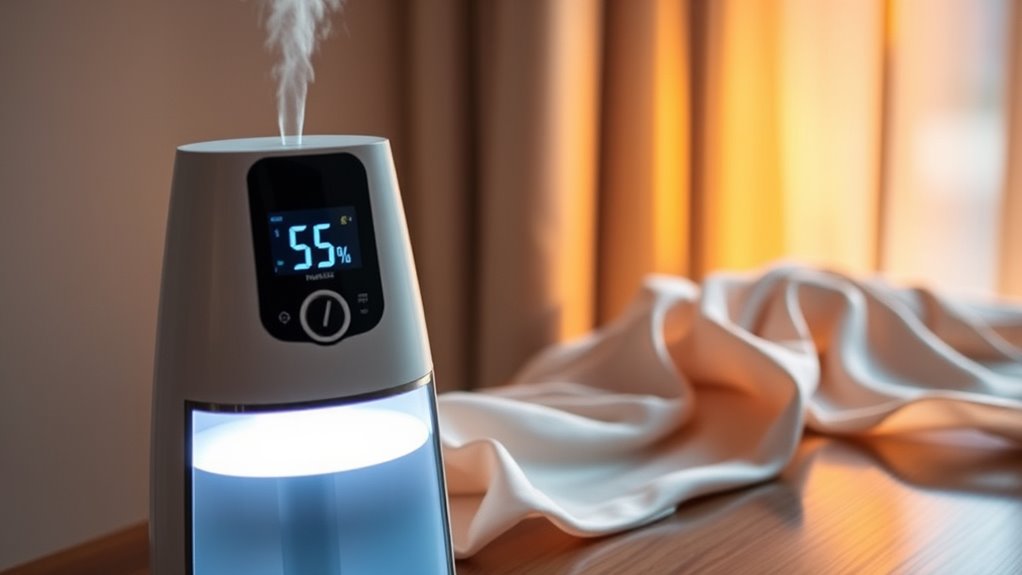
Using a hygrometer effectively alongside your humidifier guarantees you maintain the ideal humidity levels for your silk collection. Consistent monitoring ensures silk dye stability and preserves silk weaves durability. Set your hygrometer to 50-55% humidity, then adjust your humidifier accordingly. Regularly check readings to prevent fluctuations that could damage silk fibers. Avoid over-humidifying, which can cause mold or weaken silk threads. Use the following table as a quick reference:
| Humidity Level | Action | Result |
|---|---|---|
| 45-50% | Slightly increase humidifier output if needed | Maintains silk integrity |
| 50-55% | Ideal range for silk preservation | Preserves dye and weaves |
| Above 55% | Reduce humidifier to prevent excess moisture | Protects against damage |
Maintaining proper humidity levels also helps prevent mold growth, which can severely damage delicate silk textiles. Stick to these practices for long-lasting, beautifully preserved silk items.
Signs That Your Silk Items Are Suffering From Dryness
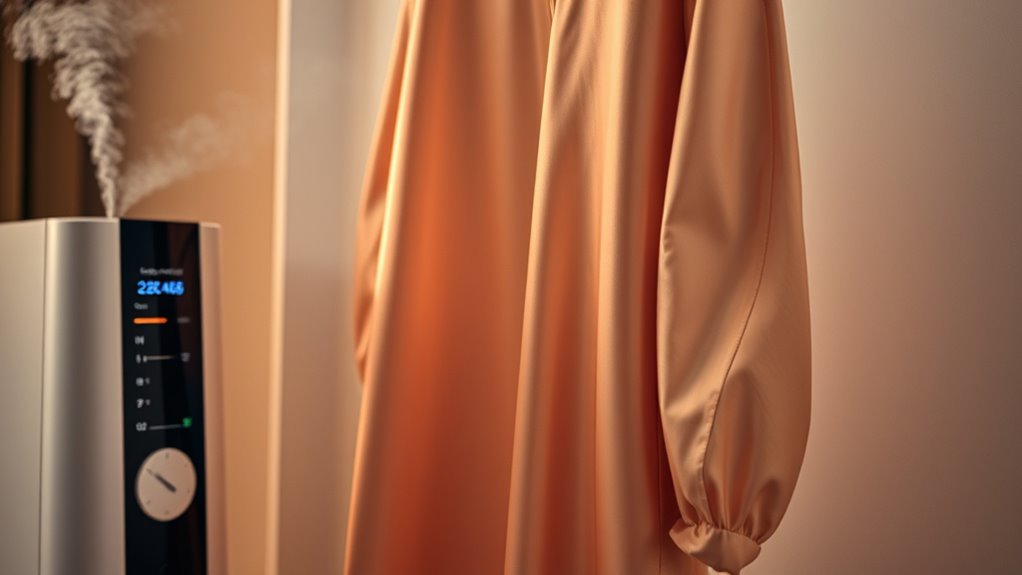
You might notice your silk items developing cracking or fraying edges if they become too dry. Feel if the fabric has lost its usual softness — dryness often makes silk feel rougher. Recognizing these signs early helps you take action before more damage occurs. Using a humidifier can help maintain optimal moisture levels and protect delicate fabrics like silk.
Cracking or Fraying Edges
When silk items become excessively dry, their edges may start to crack or fray, signaling a loss of moisture that weakens the delicate fibers. This is often seen as edge cracking or fabric fraying, which jeopardizes your silk’s integrity. Watch for:
- Fine lines along the edges, indicating the beginning of cracking.
- Frayed threads that loosen from the main fabric.
- Increased brittleness, making edges more prone to damage with minimal handling.
These signs mean your silk is suffering from dryness and needs moisture restoration. Ignoring them accelerates deterioration, so it’s essential to address the issue promptly. Proper humidity levels can prevent further damage, preserving the beauty and longevity of your silk items.
Loss of Softness
As silk items begin to lose their moisture, they also start to feel noticeably less soft and supple. Dryness can cause silk to become stiff, diminishing its natural luster. If your silk pieces, whether from silk weaving or silk dyeing, feel rougher or less pliable, it’s a clear sign they’re suffering from low humidity. Over time, this dryness can lead to cracking or fraying edges, further damaging the fabric. When silk dries out, its delicate fibers lose their elasticity, making the material more prone to damage. Maintaining proper humidity levels helps prevent fabric deterioration and preserve the quality of your silk items. To preserve the softness and integrity of your silk items, maintaining proper humidity levels is essential. Using humidifiers and hygrometers helps ensure your silk remains beautifully soft and vibrant, preventing dryness from compromising its quality.
Tips for Setting Up a Safe and Effective Humidity-Control Environment
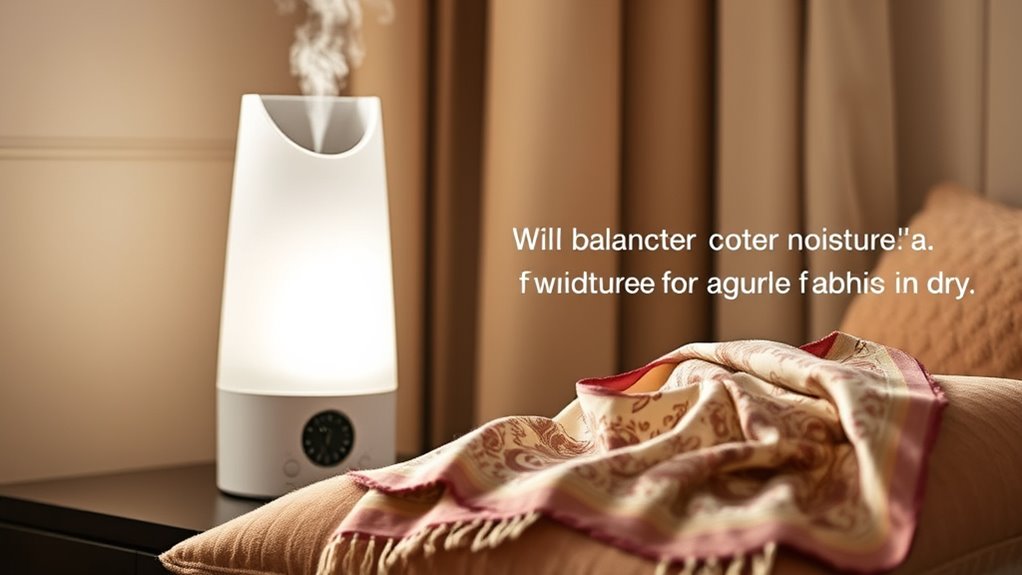
Creating a safe and effective humidity-controlled environment begins with proper placement and calibration of your humidifier and hygrometer. To protect silk through historical preservation and textile conservation techniques, follow these steps:
- Place your humidifier away from direct sunlight or vents to prevent uneven moisture levels.
- Regularly calibrate your hygrometer to guarantee accurate readings, vital for maintaining ideal humidity.
- Set your desired humidity level between 50-55%, which helps preserve silk’s softness and integrity without risking mold or damage.
- Utilize monitoring tools to keep track of humidity fluctuations and ensure consistent conditions.
Keep in mind, maintaining stable humidity reduces stress on textiles and supports long-term preservation. Proper setup creates a controlled environment that safeguards your silk items from dryness, ensuring they stay vibrant and intact over time.
Common Mistakes to Avoid When Protecting Silk in Dry Climates

Dry climates pose unique challenges for silk preservation, and overlooking common mistakes can quickly lead to damage. One mistake is neglecting to monitor humidity levels regularly, which can cause silk to become brittle or moldy. Another error is using incompatible equipment or ignoring maintenance, similar to testing concepts with unrelated topics—missteps that compromise quality. Also, avoid over-humidifying, which can lead to excess moisture and silk deterioration. Here’s a quick guide:
| Mistake | Consequence | Tip |
|---|---|---|
| Ignoring humidity levels | Damage from dryness or mold | Use reliable hygrometers |
| Using incompatible equipment | Damage or ineffective control | Choose proper humidifiers |
| Over-humidifying | Excess moisture, rot | Regularly test humidity settings |
Stay vigilant, and don’t fall into these pitfalls!
Maintaining Equipment and Ensuring Long-Term Silk Preservation

Regularly maintaining your humidification equipment is essential to preserving silk over the long term. Proper upkeep ensures accurate humidity measurement and prevents mold or damage caused by excess moisture. To keep your system in top shape, focus on three key tasks:
- Clean your humidifiers regularly to prevent silk dust and mold buildup.
- Check and calibrate humidity measurement devices for precise readings.
- Inspect and replace filters or parts as needed to maintain consistent humidity levels.
Consistent silk cleaning removes dust and residues that can attract moisture, while monitoring humidity ensures ideal conditions for silk preservation. By staying proactive with equipment maintenance, you protect your collection from fluctuations that could cause deterioration, ensuring your silk remains pristine for years to come.
Frequently Asked Questions
Can Humidifiers Cause Mold or Mildew on Silk Items?
Humidifiers can cause mold or mildew on silk if not used properly. Excess moisture creates a humid environment that promotes mold prevention and mildew control, but too much humidity can lead to damage. To protect your silk items, keep humidity levels balanced and guarantee proper airflow. Regularly monitor with a hygrometer, clean your humidifier, and avoid over-humidifying to prevent mold growth and preserve your delicate silk.
How Often Should I Calibrate My Hygrometer for Accuracy?
Precise, periodic pinpointing of your hygrometer’s accuracy is paramount. You should calibrate your hygrometer at least once a year, or more often if it’s frequently moved or exposed to temperature shifts. Regular hygrometer maintenance guarantees reliable readings, safeguarding your silk’s safety. Consistent calibration frequency keeps moisture levels manageable, preventing damage. So, commit to calibration routines—keeping your climate controlled, and your treasured textiles protected.
Are Ultrasonic Humidifiers Safe for Delicate Silk Textiles?
Ultrasonic humidifiers use ultrasonic technology to produce fine mist, which can be safe for delicate silk textiles if used properly. You should confirm the device maintains a steady, moderate humidity level and avoid direct contact with silk. Silk safety depends on controlling moisture, so monitor humidity regularly and keep the humidifier clean to prevent mold or mineral buildup. Proper use helps protect your silk from damage in dry environments.
What Is the Ideal Humidity Range for Storing Silk Long-Term?
Think of silk like a delicate flower that needs just the right moisture to stay vibrant. For silk preservation, aim for a humidity range of 50-55%. Too dry, and it becomes brittle; too moist, and it risks mold. Proper humidity control keeps your silk safe and beautiful over time. Stick to this range, and your delicate textiles will remain pristine, protected from the harshness of dry environments.
How Do I Prevent Water Damage From Humidifiers Near Silk Displays?
To prevent water damage from humidifiers near silk displays, you should carefully consider humidifier placement, keeping it away from the silk to avoid direct contact. Regularly monitor and manage the water tray, ensuring it doesn’t overflow or leak. Use a humidifier with an adjustable output and keep it on a stable, elevated surface. Proper water tray management and strategic placement help maintain ideal humidity without risking water damage.
Conclusion
Protecting precious silk in dry climates demands diligent dedication. By balancing breathable humidity with reliable hygrometers and humidifiers, you create a safe sanctuary for your silk collections. Stay vigilant, follow best practices, and avoid common mistakes to maintain their beauty and brilliance. With careful calibration and consistent care, you’ll safeguard your silk’s splendor for years to come. Remember, proper preservation isn’t just a process—it’s a promise to preserve perfection.
